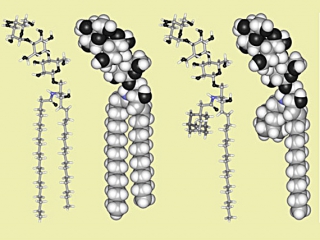Clifford A. Lingwood
Professor
BSc, University of Hull UK, 1971
PhD, University of London, 1972-1975
| Address | Rm 21-9707 Peter Gilgan Centre for Research and Learning The Hospital for Sick Children 686 Bay Street Toronto, ON M5G 0A4 |
| Lab | Lingwood Lab |
| Lab Phone | 416 813 5622 |
| Office Phone | 416 813 5998 |
| cling@sickkids.ca |
My BSc was a joint degree in Biochemistry and Zoology. My PhD at the Middlesex Hospital Medical School and National Institute for Medical Research Mill Hill was on tumour cell cycle control under Dr D.B.Thomas. I was a post doc with Dr Sen Hakomori in Seattle, where I learnt about glycosphingolipids(GSLs) and Dr Harry Schachter in Toronto where I learnt about glycoproteins, but worked on GSLs.
My research has been focussed on the function of GSLs in normal and pathophysiology, in particular on how the variable lipid moiety and its membrane environment affects function. Early work on GSL binding in spermatogenesis lead to assays which defined the GSL receptor for verotoxin (VT, shiga toxin). We found this GSL (Gb3) played a key role in VT-induced hemolytic uremic syndrome(E.coli hamburger disease). Gb3 was increased in many human cancers and their neovasculature and proposed VT as a novel antineoplastic. The male germ cell work also defined a GSL binding for hsp 70. Our development of the chemistry to generate water soluble GSL-adamantane conjugates which retained membrane receptor function, lead to a sulfogalactosyl ceramide-derived inhibitor of hsp70 and a Gb3-based inhibitor of HIV. Current work is directed to generation of a drug-like version of the latter.
We showed the accumulation of GSLs and cholesterol in membrane lipid rafts results in the masking of GSL carbohydrate within the GSL/cholesterol complex. This has widespread implications, and is particularly prevalent in cancer cells.
In the News
Research Lab

Learn more: Lingwood Lab
Research Description
Biological functions of glycosphingolipids
Our research divides into three areas related by the membrane biochemistry/chemistry of GSLs
We are using VT to probe the GSL trafficking in cells in relation to GSL synthesis. The simplest GSL, glucosyl ceramide, the precursor to most of the complex GSLs, is made on the cytosolic Golgi membrane. We are targeting the mechanism by which this precursor is flipped into the Golgi and the role of cholesterol. One candidate is the MDR1 drug efflux pump, providing a link between cancer drug resistance and GSL synthesis. We are generating probes to identify other potential flippases. Cholesterol can alter the carbohydrate conformation of membrane GSLs from a perpendicular to membrane parallel formate which significantly restricts ligand access. Increased tumour cholesterol may compromise immune surveillance of tumour associated GSL antigens.
We identified Gb3 as a natural resistance factor against against HIV infection and found adamantylGb3 to be an entry inhibitor which blocked the infection of all HIV strains tested, including drug resistant strains. The GSL binding site in the V3 loop of gp120 overlaps with that of the chemokine coreceptor. A commercial company, ViroCarb (http://www.virocarb.com) was started to develop drug-like mimics of Gb3.
Bacterial subunit toxins such as VT, undergo GSL mediated retrograde transport to the Golgi and ER. Such toxins can be derivatized to deliver tools to the ER/Golgi to aid in the folding of misfolded mutant proteins, which cause disease such as cystic fibrosis and Gaucher disease.
Publications
View all publications on PubMed





